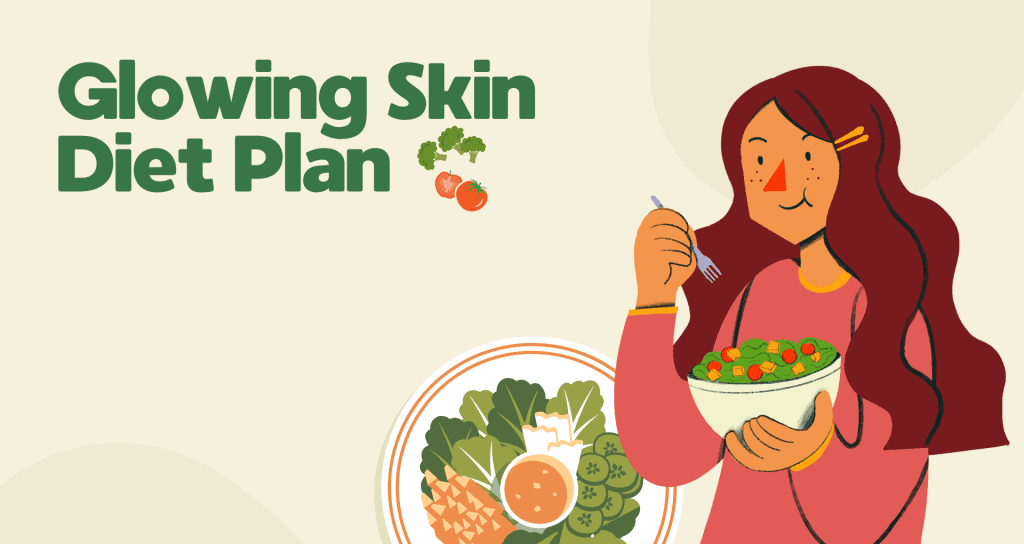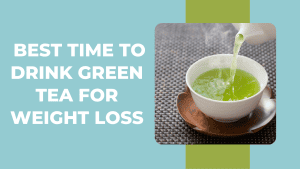Achieving radiant and glowing skin goes beyond skincare routines; it often involves adopting a balanced and nutritious diet tailored to promote skin health. A Glowing Skin diet plan incorporates foods rich in vitamins, antioxidants, and essential nutrients that support skin rejuvenation and hydration. This includes a variety of colourful fruits and vegetables, such as berries, leafy greens, and citrus fruits, which provide antioxidants like vitamin C to combat free radicals and promote collagen production. Additionally, the plan emphasizes the consumption of omega-3 fatty acids found in fatty fish, chia seeds, and walnuts, contributing to skin elasticity and moisture retention. Adequate hydration is also crucial, and water-rich foods like cucumbers and watermelon can supplement daily water intake. Following a Glowing Skin diet plan can improve skin texture, reduce inflammation, and provide a youthful glow. This plan suits individuals of all ages and skin types, especially those with dullness, dryness, or skin conditions. A sample day might include a breakfast of oatmeal with berries, a lunch with salmon and a colourful salad, and a dinner featuring quinoa, spinach, and lean protein. Embracing a Glowing Skin diet plan offers a holistic approach to skincare, enhancing both internal and external aspects for radiant and healthy skin.
What is a Glowing Skin Diet Plan?
A Glowing Skin Diet Plan is a nutritional approach designed to enhance skin health and promote a radiant complexion. This dietary regimen emphasizes consuming foods rich in vitamins, antioxidants, and essential nutrients, contributing to skin rejuvenation. Fruits like berries, leafy greens, and citrus fruits are staples, providing vital antioxidants like vitamin C to combat oxidative stress and support collagen synthesis. Including omega-3 fatty acids from sources like fatty fish and nuts aids in maintaining skin elasticity and moisture. Adequate hydration is fundamental, and water-rich foods such as cucumbers and watermelon are incorporated to complement overall water intake. This diet plan is about what to include and minimizing processed foods and sugars that can contribute to inflammation. Embracing a Glowing Skin Diet Plan is a holistic and natural approach to achieving vibrant and healthy skin from within.
7 Day Diet Plan for Glowing Skin.
A 7 Day Diet Plan for Glowing Skin is a structured and nutrient-rich approach to enhance skin health and radiance. This plan focuses on incorporating a variety of fruits, vegetables, lean proteins, and hydrating foods to nourish the skin from within.
Summary:
This 7 day diet plan for glowing skin is crafted to balance essential vitamins, antioxidants, and hydration crucial for skin rejuvenation. Each day’s menu includes a mix of colourful fruits, leafy greens, omega-3-rich foods, and ample water intake, contributing to a healthy and vibrant complexion.
7 day diet plan for glowing skin breakdown:
Day 1:
- Breakfast: Poha (Flattened Rice) with Curry Leaves and Peanuts
- Lunch: Rajma (Kidney Beans) Curry with Brown Rice
- Snack: Masala Chaas (Spiced Buttermilk)
- Dinner: Palak (Spinach) and Paneer (Indian Cottage Cheese) Sabzi with Roti
Day 2:
- Breakfast: Upma (Semolina Porridge) with Mixed Vegetables
- Lunch: Dal (Lentil) Tadka with Quinoa
- Snack: Fruit Chaat with Chaat Masala
- Dinner: Bhindi (Okra) Masala with Millet Roti
Day 3 :
- Breakfast: Vegetable Idli with Coconut Chutney
- Lunch: Chana Masala with Whole Wheat Chapati
- Snack: Cucumber Raita
- Dinner: Methi (Fenugreek) Paratha with Curd
Day 4:
- Breakfast: Moong Dal Cheela with Mint Chutney
- Lunch: Baingan Bharta with Jowar Roti
- Snack: Roasted Makhana
- Dinner: Vegetable Biryani with Raita
Day 5:
- Breakfast: Dhokla with Green Chutney
- Lunch: Vegetable Pulao with Raita
- Snack: Amla (Indian Gooseberry) Juice
- Dinner: Tofu and Vegetable Curry with Brown Rice
Day 6:
- Breakfast: Masala Oats with Curd
- Lunch: Kadhi with Steamed Brown Rice
- Snack: Grilled Paneer Tikka
- Dinner: Aloo (Potato) Gobi (Cauliflower) Curry
Day 7:
- Breakfast: Ragi (Finger Millet) Dosa with Sambhar
- Lunch: Mix Dal Khichdi with Ghee
- Snack: Roasted Almonds
- Dinner: Spinach and Moong Dal Soup with Roti
Note: This 7 day diet plan for glowing skin is made keeping in mind to provide you with the best nutrition and a turnover of results. You can adapt portion sizes based on individual dietary requirements and consult a healthcare professional before significantly changing this 7 day diet plan for glowing skin according to your preference.
Foods to eat in Glowing Skin Diet
A diet plan for glowing skin should keep in mind to incorporate nutrient-dense foods that promote skin health and radiance.
- Fruits and Vegetables
- Fatty Fish
- Nuts and Seeds
- Whole Grains
- Greek Yogurt
- Berries
- Green Tea
Lets take a sneak peek as to what foods to eat for glowing skin.
1. Fruits and Vegetables
Consuming fruits and vegetables is crucial to be added in the glowing skin meal plan as they are rich in vitamins, antioxidants, and hydration. These natural elements promote collagen production, combat free radicals, and protect against environmental damage. The vitamins and minerals in fruits and vegetables support skin regeneration and repair, contributing to a youthful complexion. The high water content in these foods ensures proper skin hydration, preventing dryness and dullness and is definitely to be included in the foods to eat for glowing skin. Additionally, fibre aids digestion, detoxifies the body and reduces skin issues. Including various fruits and vegetables in your diet nourishes the skin from within, resulting in a radiant and healthy appearance.
2. Glowing Skin
Incorporating fatty fish into your diet is essential for a diet plan for glowing skin due to its rich omega-3 fatty acids. These essential fats contribute to skin health by maintaining elasticity, reducing inflammation, and preventing dryness. Fatty fish, such as salmon and mackerel, contain eicosapentaenoic acid (EPA) and docosahexaenoic acid (DHA), which promote collagen production and protect against UV damage, enhancing skin texture and resilience. These omega-3 fatty acids also play a role in managing inflammatory skin conditions. Including fatty fish in your diet supports a well-hydrated and nourished complexion, contributing to a radiant and youthful skin appearance.
3. Nuts and Seeds
One of the most important foods to eat for glowing skin includes nuts and seeds for glowing skin as they offer a rich source of essential nutrients. Packed with omega-3 fatty acids, vitamins, and antioxidants, nuts like almonds and walnuts and seeds like chia and flaxseed promote skin elasticity, hydration, and protection against oxidative stress. These nutrients support collagen production, reduce inflammation, and create a smoother complexion. Additionally, the presence of zinc and vitamin E in nuts and seeds aids in skin repair and defends against free radicals. Integrating such a diet plan for glowing skin will nourish the skin, fostering a radiant and healthy glow.
4. Whole Grain
Whole grains are essential in the glowing skin meal plan due to their rich nutritional content. They provide a steady release of complex carbohydrates, preventing spikes in blood sugar that can lead to skin issues. Whole grains like quinoa, brown rice, and oats are rich in vitamins, minerals, and fibre, promoting skin health. Antioxidants in these grains help combat free radicals, reducing oxidative stress and supporting a youthful complexion. The fibre aids digestion, promoting a healthy gut microbiome linked to skin wellness. Including whole grains in your list of the foods to eat for glowing skin nourishes the skin from within, contributing to a radiant and luminous appearance.
5. Greek yoghurt
Greek yoghurt can be included in the glowing skin diet plan due to its nutrient-rich composition. It is high in protein and supports skin repair and regeneration, contributing to a youthful complexion. Probiotics present in Greek yoghurt promote a healthy gut microbiome, which is linked to skin health. The lactic acid in yoghurt acts as a natural exfoliant, aiding in removing dead skin cells and promoting skin renewal and therefore to be included in the foods to eat for glowing skin. Additionally, the zinc content helps regulate oil production, reducing the likelihood of acne breakouts. Including Greek yoghurt in your diet nourishes the skin with essential nutrients and supports a balanced and radiant appearance from the inside out and should definitely be part of your Balanced Diet Chart.
6. Berries
Berries are one of the most essential foods to eat for glowing skin as they are potent sources of antioxidants, particularly vitamin C and anthocyanins. These compounds combat free radicals, preventing oxidative stress and damage to skin cells. Vitamin C supports collagen synthesis, maintaining skin elasticity and resilience and thus an integral part of the glowing skin meal plan. The anti-inflammatory properties of berries reduce redness and irritation, promoting an even skin tone. Furthermore, berries contain vitamins, minerals, and fibre, improving skin health. The high water content in berries also aids in hydration, preventing dryness and promoting a supple complexion and is therefore included in the diet plan for glowing skin. Including berries in your diet supports radiant skin by addressing multiple aspects of skin health.
7. Green tea
Green tea is vital for glowing skin due to its rich antioxidant content, especially catechins. These compounds combat free radicals, protecting skin cells from oxidative stress and premature ageing. The anti-inflammatory properties of green tea help soothe the skin, reducing redness and irritation. In green tea, Epigallocatechin gallate (EGCG) promotes collagen production, enhancing skin elasticity. Additionally, green tea’s polyphenols may protect the skin from UV damage, contributing to a radiant complexion and hence an integral part of the diet plan for glowing skin. Regular consumption of green tea supports overall skin health , helping to maintain a youthful appearance by addressing inflammation and oxidative stress and promoting hydration from within and is therefore on of the Foods for clear skin.
Foods to Avoid in a Glowing Skin Diet
While adopting a Glowing Skin Diet Plan, it’s crucial to be mindful of certain foods hindering your quest for radiant skin.
- Processed Foods
- Sugary Treats
- Dairy Products
- Highly Salty Foods
- Alcohol
- Fried and Greasy Foods
- Caffeine Overload
- Gluten-rich Foods
1. Processed foods
Processed foods should be avoided in the diet plan for glowing skin because they often contain highly refined sugars, unhealthy fats, and artificial additives. These elements can trigger inflammation and oxidative stress, leading to skin issues such as acne and premature ageing. Additionally, processed foods lack the essential nutrients, vitamins, and antioxidants for skin health. The excessive intake of these foods may disrupt the skin’s balance, hindering its ability to regenerate and maintain a radiant complexion. Opting for whole, unprocessed foods ensures a more nutrient-dense and skin-friendly diet plan for glowing skin .
2. Sugary Treats
Sugary treats should be avoided in the diet plan for glowing skin as excess sugar intake can lead to glycation, where sugars bind to proteins like collagen, impairing their function. This results in the formation of advanced glycation end products (AGEs), contributing to skin ageing, wrinkles, and loss of elasticity and therefore the consumption of sugar should be lessened in the glowing skin meal plan. Moreover, high sugar consumption can spike insulin levels, promoting inflammation and exacerbating skin conditions like acne. Limiting sugary treats helps maintain stable blood sugar levels and supports overall skin health, reducing the risk of premature ageing and ensuring a more radiant complexion.
3. Dairy Products
Avoiding dairy products benefits glowing skin as they can contribute to skin issues. Dairy may contain hormones stimulating oil production, leading to acne breakouts. Moreover, some individuals are lactose intolerant or sensitive to dairy proteins, which can manifest in skin inflammation and irritation. Additionally, the natural hormones present in dairy can disrupt the hormonal balance, exacerbating skin conditions. Individuals can potentially mitigate these adverse effects by eliminating or reducing their dairy consumption in the diet plan for glowing skin, promoting more transparent, healthier skin and supporting a radiant complexion. Opting for dairy alternatives can be wise for those seeking skin-friendly dietary options.
4. High Salty Foods
Avoiding high-salt foods is crucial for glowing skin, as excessive salt intake can lead to water retention, causing puffiness and swelling. High sodium levels disrupt the balance of fluids in the body, leading to dehydrated skin and a lacklustre complexion. The retained water can also pressure blood vessels, affecting circulation and contributing to under-eye bags. The inflammatory response triggered by excess salt can also exacerbate skin conditions like acne and eczema. Opting for a low-sodium diet plan for glowing skin help maintain proper hydration, reduces inflammation, and supports the overall health and radiance of the skin, ensuring a more vibrant appearance.
5. Alcohol
Avoiding alcohol is essential for glowing skin as it dehydrates the body, robbing the skin of moisture and leaving it dull and tired. Alcohol also dilates blood vessels, leading to redness and exacerbating conditions like rosacea. It hinders the body’s ability to absorb essential nutrients, impacting collagen production and premature ageing. Additionally, alcohol can disrupt sleep patterns and impede the skin’s natural repair processes during rest and hence one should subsequently limit the amount of alcohol from the glowing skin meal plan. The toxins in alcoholic beverages may also trigger inflammation, leading to skin issues like acne. Limiting or eliminating alcohol supports skin hydration, reduces inflammation, and promotes a more radiant complexion.
6. Fried and Greasy foods
Avoiding fried and greasy foods is crucial for glowing skin as they often contain trans fats that contribute to inflammation, leading to skin issues like acne and redness. These unhealthy fats can also compromise the skin’s natural barrier, making it more prone to dehydration and dullness. Fried foods lack essential nutrients and antioxidants vital for skin health, hindering the body’s ability to repair and regenerate. Additionally, a diet high in trans fats promotes oxidative stress, accelerating ageing and diminishing the skin’s natural radiance making it important to lessen its consumption in the glowing skin meal plan. Eating healthier cooking methods and incorporating nutrient-dense foods supports a vibrant complexion hence should be included in the diet plan for glowing skin. to avoid the hassle of to include in the diet you can look into the Healthy Recipes.
7. Caffeine Overload
Avoiding caffeine overload is essential for glowing skin, as excessive consumption can lead to dehydration, making the skin appear dull and tired. Caffeine is a diuretic, promoting increased urine production and potentially robbing the skin of essential moisture. Dehydrated skin is more prone to fine lines and wrinkles. Moreover, excessive caffeine can disrupt sleep patterns, hindering the skin’s natural rejuvenation process at night. Chronic sleep deprivation may result in a lacklustre complexion, dark circles, and increased stress levels, which can contribute to skin issues. Moderation in caffeine intake ensures proper hydration, supports skin health, and maintains a radiant appearance.
8. Gluten Rich Foods
Avoiding gluten-rich foods is essential for glowing skin as gluten can trigger inflammation in sensitive individuals, potentially exacerbating skin conditions like acne, eczema, or psoriasis. For those with gluten intolerance, the immune response to gluten can manifest in skin issues. Gluten-containing grains may also contribute to gut imbalances, affecting overall skin health. Gluten-rich processed foods often lack the nutrients and antioxidants vital for a radiant complexion. Opting for gluten-free alternatives, such as quinoa or rice, supports a healthier gut, reduces inflammation, and promotes more transparent, luminous skin.
Benefits of Glowing Skin Diet Plan
A Glowing Skin Diet Plan offers a holistic approach to skincare by emphasizing nutrient-rich foods. This dietary regimen aims to enhance skin health from within, providing a range of benefits for a radiant complexion.
Benefits of Glowing Skin Diet Plan:
- Radiant Complexion: This glowing skin meal plan emphasizes on fruits, vegetables, and omega-3-rich foods promotes collagen synthesis, contributing to a luminous and youthful appearance.
- Reduced Inflammation: Antioxidant-rich foods combat inflammation, lowering the risk of skin issues like acne and redness.
- Hydration and Elasticity: Water-rich foods and omega-3 fatty acids maintain skin hydration and elasticity, preventing dryness and fine lines.Check into the Detox water recipes for more information,
- Overall Skin Health: Essential nutrients support skin repair, regeneration, and protection against environmental damage, fostering a healthy and vibrant complexion.
How to follow a Glowing Skin Diet Plan
Following a Glowing Skin Diet Plan involves incorporating nutrient-dense foods and making mindful choices to promote skin health. Adopting key strategies can help individuals adhere to this dietary regimen for a radiant complexion.
Tips for Following a Glowing Skin Diet Plan:
- Diversify Your Plate: Include a variety of colorful fruits, vegetables, lean proteins, and whole grains for a broad spectrum of nutrients in the glowing skin meal plan.
- Stay Hydrated: Consume water-rich foods and maintain adequate water intake to support skin hydration.
- Limit Processed Foods: Minimize the intake of processed and sugary items that can contribute to inflammation and skin issues.
- Incorporate Healthy Fats: Include sources of omega-3 fatty acids, like fatty fish and nuts, to promote skin elasticity and moisture in the glowing skin meal plan.
Important nutrients for Glowing Skin
Certain nutrients play a crucial role in supporting skin health to achieve glowing skin. Incorporating these essential elements into your diet can contribute to a vibrant complexion.
Essential Nutrients for Glowing Skin:
- Vitamin C: Found in citrus fruits, berries, and leafy greens, it promotes collagen production and protects against oxidative stress.
- Vitamin E: Present in nuts, seeds, and spinach, it acts as a powerful antioxidant, supporting skin repair and hydration.
- Omega-3 Fatty Acids: Fatty fish, chia seeds, and walnuts provide these essential fats, enhancing skin elasticity and reducing inflammation.
- Zinc: Found in pumpkin seeds and chickpeas, it supports skin healing and helps regulate oil production.
- Antioxidants: Present in various fruits and vegetables, they combat free radicals and prevent premature ageing.
Expert Review on Glowing Skin Diet Plan
The Glowing Skin Diet Plan is a holistic approach to skincare that emphasizes nutrition for radiant and healthy skin. Centred around nutrient-dense foods, this dietary regimen incorporates a diverse range of colourful fruits, vegetables, lean proteins, and whole grains. Rich in essential vitamins, antioxidants, and omega-3 fatty acids, these elements contribute to collagen synthesis, combat free radicals, and promote skin elasticity. The plan also encourages hydration through water-rich foods and adequate water intake. Individuals can minimize inflammation and reduce the risk of skin issues by limiting processed foods and sugars. Following this plan fosters overall skin health, addressing hydration and inflammation and providing the necessary nutrients for skin repair and regeneration. A commitment to the Glowing Skin Diet Plan offers a natural and comprehensive approach to achieving and maintaining a luminous complexion.
References
FAQs
What is the best diet for glowing skin?
The best diet plan for glowing skin is to include a variety of colourful fruits, vegetables, lean proteins, and whole grains. Incorporate foods rich in vitamins, antioxidants, and omega-3 fatty acids. Stay hydrated, limit processed foods, and maintain a balanced diet to promote collagen production, reduce inflammation, and achieve a radiant complexion.
What foods whiten skin?
While no foods can permanently lighten skin tone, some may contribute to overall health. Foods rich in vitamin C, like citrus fruits, strawberries, and bell peppers, may help brighten the complexion. Additionally, consuming foods with antioxidants, such as green tea and tomatoes, can support skin health and radiance.
Which diet is good for fair skin?
Achieving fair skin involves maintaining overall skin health. A glowing skin meal plan which is rich in fruits, vegetables, and antioxidants supports skin radiance. Foods high in vitamin C, such as berries and citrus fruits, contribute to an even complexion. Staying hydrated, consuming omega-3 fatty acids, and limiting processed foods can enhance skin health for a naturally glowing appearance.
What foods make your skin pink?
Consuming foods that promote blood circulation can contribute to a natural pinkish complexion. Include beets, tomatoes, and berries rich in antioxidants. Additionally, leafy greens, which are high in iron, and watermelon, with their hydrating properties, can support healthy blood flow, potentially enhancing a rosy glow in the skin and therefore should be an integral part of the glowing skin meal plan.
How do you get fair skin?
To promote fair skin:
- Prioritize sun protection to prevent darkening.
- Maintaining a healthy diet plan for glowing skin which shall include fruits, vegetables, and antioxidants that supports skin health.
- Stay hydrated, get adequate sleep, and use skincare products with ingredients like vitamin C. Remember, embracing your natural skin tone and practising good skincare contribute to a vibrant complexion.









